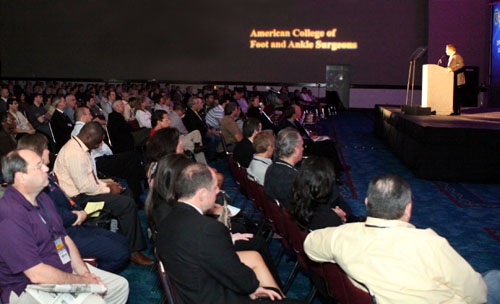Leading surgeons focus on next generation of care

Michael S. Lee, DPM, FACFAS, Immediate Past President of the American College of Foot and Ankle Surgeons, welcomes almost 1100 attendees to the 69th Annual Scientific Conference in Ft. Lauderdale. The annual conference is the premiere educational program for the nation's foot and ankle surgeons.
CHICAGO—March 12, 2011 Foot and ankle surgeons from around the nation gathered this week to lead the way in advancing patient care and technology at the 69th Annual Scientific Conference of the American College of Foot and Ankle Surgeons in Fort Lauderdale.
Conference Highlights and Hot Topics
Advancing Tissue Healing Without Surgery
Foot and ankle surgeons are using a new procedure called Platelet Rich Plasma (PRP) therapy to promote the healing of bones, cartilage, blood vessels, tendons and tissues to heal not only professional athletes but also the “weekend warriors” as well as diabetics.
Surgeons, including Sean Grambart, DPM, FACFAS, an Illinois foot and ankle surgeon, have seen positive outcomes for patients with chronic Achilles tendon pain, bone healing for non-unions and acute ligament injuries in athletes. “The biggest advantage of PRP is the recovery is much easier for patients,” he said. “Instead of performing a surgical procedure that involves opening the Achilles tendon, removing scar tissue and requiring a six-month recovery period for the patient, we can inject PRP into the tendon to bring the growth factors directly to the tendon, which can stimulate healing.”
Surgeons Can Now Get Bones, Stem Cells “Off the Shelf”
When patients need a bone graft for a foot or ankle surgery, bone often is taken from another part Conference Highlights and Hot Topics
of their body. Now surgeons are using new methods to get bone material and even stem cells right “off the shelf,” according to Glenn M. Weinraub, DPM, FACFAS, a California foot and ankle surgeon who led a discussion among surgeons on the next decade of bone healing.
“Harvesting a patient’s own bone has always been considered the gold standard, but nowadays I think that concept should be thought of as the historical standard,” said Dr. Weinraub, president of ACFAS. “The quality of the material that is available in a prepackaged format has been shown to be just as effective for bone healing and may yield fewer complications for the patient.”
Small Scars, Big Benefits
Performing arthroscopic surgery on a foot or ankle ailment offers patients more than just a smaller scar, according to surgeons discussing the successes through small incisions at the Annual Scientific Conference.
While the use of arthroscopic surgery has been around for many years, the benefits of performing surgeries arthroscopically, which allows surgeons to repair common ailments using high-tech cameras and arthroscopic surgical equipment through one-quarter of an inch or smaller incisions, continue to increase for patients, especially in the area of foot and ankle surgery.
“The use of arthroscopy or minimally invasive techniques offer patients many advantages over traditional surgery, including decreased pain, fewer complications, lower risk of infection and quicker recovery time,” Iowa foot and ankle surgeon Michael S. Lee, DPM, FACFAS, said.
New technology is also paving the way for better outcomes for patients undergoing minimally invasive surgery. For example, foot and ankle surgeons are using high-definition monitors and scopes during arthroscopic surgery, and improved instruments allow injuries that once required invasive surgery to be treated arthroscopically, Dr. Lee added.
